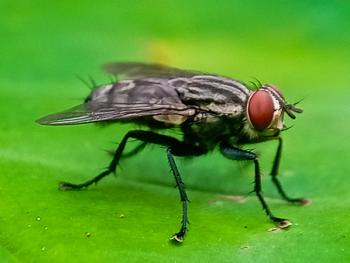
Ticks: The (bizarre) nature of the beast
Think you know ticks? Think again. Here are some facts about the tenacious tick that may surprise you.
If your clients tell you that they made sure to get the tick's head out, you can let them know that ticks don't have heads. They're just mouths attached to guts. Yum. (tverdohlib/stock.adobe.com)
Every veterinary professional knows ticks are a year-round concern for dogs and cats. But there are lots of things about these hardy arachnids that you may be unaware of-and may (or may not!) want to share with your clients the next time you're talking parasites.
These facts about ticks come courtesy of parasitologists at Kansas State University's Tick Camp, a veterinary media event sponsored each summer by Boehringer Ingelheim.
About 900 species of ticks can be found worldwide. While many tick species are completely harmless, a few can really do some damage to both pets and people (and
Ticks can survive two weeks underwater. Flushing them down the toilet will get them out of your house or clinic, but it won't kill them. (Here's a client handout on the dos and don'ts of
Some soft ticks can live up to 20 years. But most hard and soft ticks live for about two or three years, generally eating only three meals during their lifetime.
Ticks are headless. Ticks basically have a gigantic mouth attached to a gigantic gut, which means they need a massive meal. In more technical terms, a tick's three mouthparts (collectively known as the capitulum) are the hypostome (the barbed, needle-like structure ticks use to suck blood), the chelicerae (a pair of telescoping “teeth” that cut the host's skin to make room for the hypostome) and the palps (two jointed sensory structures flanking the hypostome that do not penetrate the skin).
Some ticks have eyes. Actually, they're more like photo receptors located on the tick's back. These structures can detect light, shadows and movement, but they don't help much when it comes to finding a host. In a behavior called “questing,” most ticks detect a host's breath and body odors (anything that emits carbon dioxide) or sense body heat, moisture or vibrations. The tick waits on a blade of grass or shrub and latches onto a passing host with its two front legs.
Ticks stick together. If you're outside and encounter a clump of what looks like five to 10 ticks, that small group only represents 0.00046% to 0.00019% of the population in that immediate area. And remember, ticks cannot fly, jump or drop from trees. They need to make physical contact to latch on to a host.
Ticks hibernate. It's called “diapause,” and it typically happens after a bloodmeal and/or after molting. Ticks hibernate until they've “hardened” into their new life stage. Once the temperature gets high enough, they're ready to feed again.
But ticks aren't the only pet-loving parasite with unique traits. Check out these fun
Newsletter
From exam room tips to practice management insights, get trusted veterinary news delivered straight to your inbox—subscribe to dvm360.






